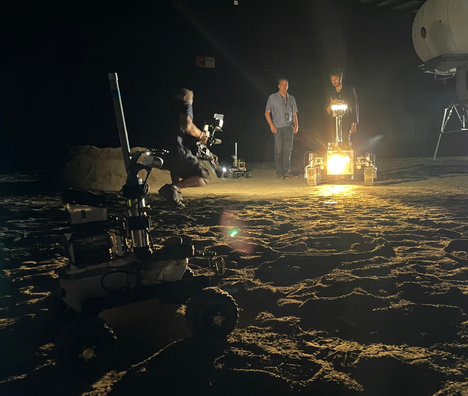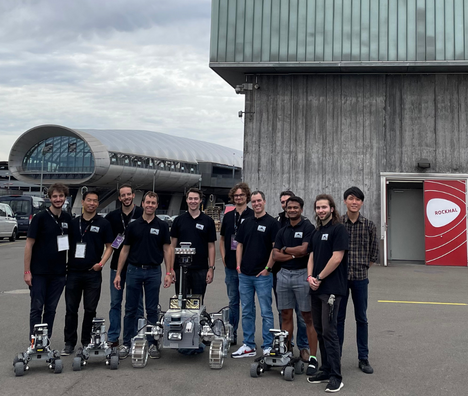In early September, in a concert hall normally filled with the deafening bass line of the latest rock band, instead there was only quiet sounds of clicks and buzzing. The thing that is often overlooked about the moon is how quiet it is; and the European Space Agency (ESA) with the European Space Resources Centre (ESRIC) were running the show that week.
For four days they turned the Rockhal concert centre in Luxembourg into a replica of the moon’s surface for the final instalment of the ESA/ESRIC Space Resources Challenge. Here four teams from Europe and one from Canada brought their lunar rovers to undergo the ultimate test and compete for an opportunity to send their technology to the moon.
One team was an international collaboration between the SpaceR research group at the University of Luxembourg’s Interdisciplinary Centre for Security, Reliability and Trust (SnT), Space Applications Services (SAS), and four other universities and organisations from France, Belgium, and the UK. Team name LUVMI-XR.
In Rockhal that day, five team members of LUVMI-XR sat upstairs in the green room about to navigate their rovers remotely across terrain they had never seen. Craters, rocks, and a lunar lander were all waiting to surprise them as they explored this new landscape. In a room where hit musicians normally relax before and after their big performance, instead there was a tense energy. The five scientists sat at seven computer screens as they began to guide their rovers. Their mission was to map as much of the area as they could, find resources, and send their rover’s data ‘back to Earth’, all in four hours, with another hour to complete a preliminary report.
The first step to mapping the area is for a rover to do a 360-degree turn. This allows it to gather a complete data set and then proceed in the appropriate direction. They repeat this pirouette action ever so often, as they get further and further into the landscape, as if performing a slow space ballet across the dusty surface of the synthetic moon.
Speed in this competition is a unique experience. The rovers can only travel across the surface at 0.05 m/s when mapping, meaning that the team in their remote-control green room need to be patient, while at the same time racing against the clock. As they progress further into the terrain the judges from ESA and ESRIC keep a watchful eye. The jury is evaluating how the team’s rover technology functions, but also how they cooperate as a team and the strategies that they use, among many other factors.
The first hour passed without incident, the team in the room liaising with more LUVMI-XR members joined remotely over mobile from an office close by. There was clear confidence in the room; they’d been working towards this for 13 months. They were building multiple different maps simultaneously, each for a specific purpose, as each of the four rovers also had their role to play in achieving the mission objectives. Three of the rovers were small ‘scout’ rovers, using a modified Leo Rover platform, and then there was the larger LUVMI-X rover with the main computer for the science mission. In this competition the science mission is worth 100 points — and at 10:45, the computer went down.
When a computer crashes on Earth the easiest solution is to restart it. But in this competition their rover was not on Earth, just several meters away from where they were sitting, it was on the moon.
They were left with a choice, continue to competition without the computer on their main rover, or use what was called ‘the Golden Ticket’. The golden ticket is both a blessing and a curse; it would allow them to send one of the team members into the concert hall to find the LUVMI-X rover and restart the computer. But the team member would not be allowed to come back from their “moon walk”, and with two hours left to go, missing one person was significant.
The team decided that it was worth it, and team member Fabio Polisano made his way through the halls towards the moon. And just like the musicians walking these halls followed by cameras documenting their experience on their rock tour of Europe, so was he followed by a camera and an entourage taking in his moment of sacrifice. Down the stairs and down a dark hallway hung the curtains protecting the lunar surface from view. Accompanied by a judge to ensure the rules were followed, Polisano stepped onto the basalt surface and approached the LUVMI-X rover. In the space of a couple minutes the computer was up and running again. But as he left the analogue lunar terrain his shoulders were drooped, knowing that he would be unable to help his team as they continued the second half of the competition.

“It’s hard to wait. Knowing that they’re up there, now shorthanded, and what they have left to do,” said Polisano
Upstairs, the four remaining scientists carried on. “I think I’ve found something,” said Dave van der Meer, Doctoral Researcher at SnT. “It looks like a huge structure.” They had finally encountered the massive lunar lander. An impressive structure in the middle of the terrain. Towering over the other craters and boulders. Their map continued to grow, and data was being collected at a rapid rate at this point. Then at 11:30, they lost Leo Rover Leo02. And more importantly, its data.

These challenges all came on top of the obstacles and exigent scenarios the judges had planned. Since the start they had been dealing with communication cut offs intermittently, just as scientists would experience in a real lunar mission. The jury was there to consider how they responded to such challenges. As space is the opposite of a welcoming environment.
The rest of the team in an office of the University of Luxembourg a few blocks away could not help them with such immediate decisions. The four in the room were alone trying to get everything done before 1:00 o’clock came. As the deadline for their prospecting mission came ever closer the team changed their priorities. Now the most important thing was to download the data that they had collected, using the limited bandwidth scenario that was replicating a real lunar mission. They moved all their bandwidth to Leo03 so that they could fetch as much data as possible before the prospecting mission was complete. Then, 10 minutes before the end of their mission, the judges came with another twist. This time, the team was presented with a set of playing cards face down. Each card represented one of the assets they had on the ground, and they had to choose one card and that asset would then be shut down. The team picked a card, and when it turned over the judges announced that Leo03 was going to be shut down, meaning the team would lose 60% of the data they had left to transfer.
This is the way it is with space missions. Things don’t go to plan. Thinking on your feet and the way you react to the unexpected makes the difference between success and failure, whether it is for a competition on Earth, or the real thing one day.
The team completed the challenge and preliminary report that day, and now are working on further reporting that is part of the competition. The winner will be announced in the coming months, and the team that wins will get the opportunity to develop their technology further and eventually launch their rover to the moon on an ESA mission.
Watch SnT’s and Prof. Miguel Olivares-Mendez LinkedIn and Twitter to support our team as they wait for the announcement!

LUVMI-XR Team Members (left to right):Fabio Polisano, Gen Ito, Matteo de Benedetti, Jeremi Gancet, Dave van der Meer, Loïck Chovet, Miguel Olivares Mendez, Ernest Skrzypczyk, Abhishek Bera, Gabriel Garcia, Ayumi Umemura
